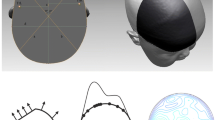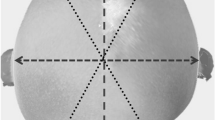Abstract
Objective
Stereophotogrammetry enables a simple and radiation free longitudinal analysis of skull asymmetries: in a three-dimensional coordinate system various distances (length, breadth, cephalic index, oblique diameters, ear shift, head circumference) can be analyzed. We also defined separate volume sections in order to further quantify the degree of asymmetry in the posterior and anterior components of both sides of the head.
Patients and methods
In 51 infants (mean age, 6 months; SD 0.97) with positional plagiocephaly, we determined these parameters at the beginning as well as at the end of molding helmet therapy (mean therapy time 4.9 months). Thirty-seven infants without positional deformity (mean age, 6.4 months; SD 0.3) served as control group and provided data about what appears to be normal and how these parameters change during growth over a comparable period of time.
Results
Compared with the control group, the plagiocephalic heads were more brachycephalic, but closely approximated the normal shape under molding therapy. The striking volume difference between the left and right posterior sections in the plagiocephalic children (the mean volume of the flattened side being 21 % smaller than the one on the contralateral side) improved as well (to a residual difference of mean 8 %) and ended up with a value close to the control group (mean 6 %).
Conclusion
There is a broad clinical application area for stereophotogrammetry analyzing skull morphology: In plagiocephalic infants we demonstrate impressive changes of head shape under molding therapy; in normal-looking infants we describe the extent of unperceived asymmetry.

Similar content being viewed by others
References
Peitsch WK, Keefer CH, LaBrie RA, Mulliken JB (2002) Incidence of cranial asymmetry in healthy newborns. Pediatrics 110:e72
Glasgow TS, Siddiqi F, Hoff C, Young PC (2007) Deformational plagiocephaly: development of an objective measure and determination of its prevalence in primary care. J Craniofac Surg 18:85–92
Moss SD (1997) Nonsurgical, nonorthotic treatment of occipital plagiocephaly: what is the natural history of the misshapen neonatal head. J Neurosurg 87:667–670
Argenta L, David L, Thompson J (2004) Clinical classification of positional plagiocephaly. J Craniofac Surg 15:368–372
Danby PM (1962) Plagiocephaly in some 10-year-old children. Arch Dis Child 37:500–504
Hutchison B, Hutchison L, Thompson J, Mitchell E (2004) Plagiocephaly and brachycephaly in the first two years of life: a prospective cohort study. Pediatrics 114:970–980
Boere-Boonekamp M, van der Linden-Kuiper LTL (2001) Positional preference: prevalence in infants and follow-up after two years. Pediatrics 107:339–343
Visscher F, van der Graaf T, Spaans M, van Lingen RA, Fetter WP (1998) Prone position favors motor development of infants. Ned Tijdschr Geneeskd 142:2201–2205
Hunt CE, Puczynski MS (1996) Does supine sleeping cause asymmetric heads? Pediatrics 98:127–129
Persing J, James H, Swanson J, Kattwinkel J, American Academy of Pediatrics Committee on Practice and Ambulatory Medicine ScoPSaSoNS (2003) Prevention and management of positional skull deformities in infants. American Academy of Pediatrics Committee on practice and ambulatory medicine, section on plastic surgery and section on neurological surgery. Pediatrics 112:199–202
Hutchison BL, Thompson JM, Mitchell EA (2003) Determinants of nonsynostotic plagiocephaly: a case–control study. Pediatrics 112:e316
Collett BR, Heike CL, Atmosukarto I, Starr JR, Cunningham ML, Speltz ML (2012) Longitudinal, three-dimensional analysis of head shape in children with and without deformational plagiocephaly or brachycephaly. J Pediatr 160:673–678
Schaaf H, Wilbrand JF, Boedeker RH, Howaldt HP (2010) Accuracy of photographic assessment compared with standard anthropometric measurements in nonsynostotic cranial deformities. Cleft Palate Craniofac J 47:447–453
Mortenson PA, Steinbok P (2006) Quantifying positional plagiocephaly: reliability and validity of anthropometric measurements. J Craniofac Surg 17:413–419
Captier G, Dessauge D, Picot MC, Bigorre M, Gossard C, El Ammar J, Leboucq N (2011) Classification and pathogenic models of unintentional postural cranial deformities in infants: plagiocephalies and brachycephalies. J Craniofac Surg 22:33–41
Frühwald J, Schicho KA, Figl M, Benesch T, Watzinger F, Kainberger F (2008) Accuracy of craniofacial measurements: computed tomography and three-dimensional computed tomography compared with stereolithographic models. J Craniofac Surg 19:22–26
Brenner D, Hall E (2007) Computed tomography—an increasing source of radiation exposure. N Engl J Med 357:2277–2284
Pearce MS, Salotti JA, Little MP, McHugh K, Lee C, Kim KP, Howe NL, Ronckers CM, Rajaraman P, Craft AW, Parker L, de González AB (2012) Radiation exposure from CT scans in childhood and subsequent risk of leukaemia and brain tumours: a retrospective cohort study. Lancet 380:499–505
Meyer-Marcotty P, Böhm H, Linz C, Kunz F, Keil N, Stellzig-Eisenhauer A, Schweitzer T (2012) Head orthesis therapy in infants with unilateral positional plagiocephaly: an interdisciplinary approach to broadening the range of orthodontic treatment. J Orofac Orthop 73:151–165
Meyer-Marcotty P, Alpers GW, Gerdes AB, Stellzig-Eisenhauer A (2010) Impact of facial asymmetry in visual perception: a 3-dimensional data analysis. Am J Orthod Dentofacial Orthop 137(168):e161–e168, discussion 168–169
Dahlberg G (1940) Statistical methods for medical and biological students. George Allen and Unwin, London
McKay DR, Davidge KM, Williams SK, Ellis LA, Chong DK, Teixeira RP, Greensmith AL, Holmes AD (2010) Measuring cranial vault volume with three-dimensional photography: a method of measurement comparable to the gold standard. J Craniofac Surg 21:1419–1422
Schaaf H, Pons-Kuehnemann J, Malik CY, Streckbein P, Preuss M, Howaldt HP, Wilbrand JF (2010) Accuracy of three-dimensional photogrammetric images in non-synostotic cranial deformities. Neuropediatrics 41:24–29
Xia JJ, Kennedy KA, Teichgraeber JF, Wu KQ, Baumgartner JB, Gateno J (2008) Nonsurgical treatment of deformational plagiocephaly: a systematic review. Arch Pediatr Adolesc Med 162:719–727
McGarry A, Dixon MT, Greig RJ, Hamilton DR, Sexton S, Smart H (2008) Head shape measurement standards and cranial orthoses in the treatment of infants with deformational plagiocephaly. Dev Med Child Neurol 50:568–576
Graham JM, Kreutzman J, Earl D, Halberg A, Samayoa C, Guo X (2005) Deformational brachycephaly in supine-sleeping infants. J Pediatr 146:253–257
Kane A, Mitchell L, Craven K, Marsh J (1996) Observations on a recent increase in plagiocephaly without synostosis. Pediatrics 97:877–885
Dekaban AS (1977) Tables of cranial and orbital measurements, cranial volume, and derived indexes in males and females from 7 days to 20 years of age. Ann Neurol 2:485–491
Wilbrand JF, Wilbrand M, Malik CY, Howaldt HP, Streckbein P, Schaaf H, Kerkmann H (2012) Complications in helmet therapy. J Craniomaxillofac Surg 40:341–346
Lipira AB, Gordon S, Darvann TA, Hermann NV, Van Pelt AE, Naidoo SD, Govier D, Kane AA (2010) Helmet versus active repositioning for plagiocephaly: a three-dimensional analysis. Pediatrics 126:e936–e945
Acknowledgments
This investigation was supported by grants from the Interdisciplinary Center for Clinical Research at the Medical Faculty of the University of Würzburg, Germany.
Funding source
This investigation was supported by grants from the Interdisciplinary Center for Clinical Research at the Medical Faculty of the University of Würzburg, Germany.
Financial disclosure
The authors have no financial relationships relevant to this article to disclose.
Conflict of Interest
The authors have no conflicts of interest to disclose.
Author information
Authors and Affiliations
Corresponding author
Rights and permissions
About this article
Cite this article
Schweitzer, T., Böhm, H., Linz, C. et al. Three-dimensional analysis of positional plagiocephaly before and after molding helmet therapy in comparison to normal head growth. Childs Nerv Syst 29, 1155–1161 (2013). https://doi.org/10.1007/s00381-013-2030-y
Received:
Accepted:
Published:
Issue Date:
DOI: https://doi.org/10.1007/s00381-013-2030-y




